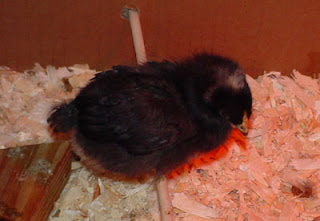We have some chick worries. A couple of the chicks showed early signs of the dreaded pasty butt. If poop dries in their vent (the combined opening for the reproductive, excretory, and reproductive tracts), they can become permanently plugged and die. When I first heard about it, it seemed disgusting to deal with, but it really is not that hard to wipe their little bums with a wet paper towel and/or carefully cut the dried material away with scissors. The new worry was that we had been a bit too aggressive, as a couple of them ended up with naked bums. For the most part, they look quite healthy.
The chicks are using the perch more and testing out their flight feathers. The change from day to day is remarkable.
 |
| I think I can fly! |
 |
| Dominique perching |
After chicken chores we planted the potatoes. The soil was perfect. Slightly moist but easy to work. Terry dug the holes, Hilda cut the potatoes, I put the potatoes in the holes and covered them up, and Hilda put down markers. After many years of planning to mark the potatoes when I planted them, it finally came to pass. No more trying to find the hills long after the plants have died back. We ran out of seed potatoes about halfway through the fifth row. Terry retrieved some sprouted potatoes from the cellar to finish out the row. We are still eating last year's potatoes, despite sprouts that are approaching a meter in length. The Native Americans referred to the full moon in February as the Hunger Moon. In our house, the months of February through June are the Moons of the Wrinkled Potatoes. This year, I tried leaving some of the sprouts above ground. I think they will turn green. I am photodocumenting for possible inclusion into my Plant Science course.
 |
| Potato sprout one day after planting. No green yet. |
 |
| Lupin sprouts |
 |
| Trillium in their new home |
No comments:
Post a Comment